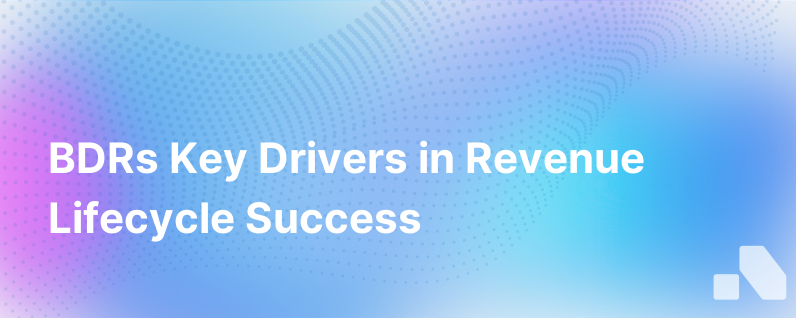Bdrs Play The Most Important Role In The Revenue Lifecycle
Published on August 22, 2023 by Sawyer Middeleer
Business Development Representatives (BDRs) maintain an essential foothold within any robust revenue lifecycle of a modern enterprise. While often occupying one of the first stages in the broad spectrum of direct sales and customer acquisition processes, BDRs' roles transcend the boundaries of mere lead generation. Their strategic importance in fueling the engine of growth cannot be overstated, serving as linchpins between market signals and the company's revenue trajectory.
The Multi-faceted Role of BDRs
To appreciate the impactful role BDRs play, we must first deconstruct the notion that their primary function is to simply fill the top of the sales funnel with potential leads. On the contrary, BDRs are strategic operatives, tactfully navigating through markets to seek out high potential business opportunities. They are the first point of contact that a prospective client often has with a company, and as such, BDRs possess the onerous responsibility of making powerful first impressions. Let's explore the myriad ways through which BDRs significantly contribute to the revenue lifecycle.
The Gatekeepers of Opportunity
At their core, BDRs are refined researchers and opportunity seekers. Through meticulous prospecting, they identify and qualify potential leads that fit the ideal customer profile. They are the gatekeepers who ensure that the sales pipeline is not just plentiful, but high in quality. By sifting through the multitudes, they lay the groundwork that protects valuable sales resources from being expended on low-return engagements.
Crafting Tailored Experiences
Through direct engagement, BDRs collect critical data points on prospective clients. They identify the unique needs, challenges, and pain points of businesses, which in turn, provides invaluable insights. These insights facilitate the crafting of tailored solutions and enable personalized interactions as the prospect advances through the sales funnel.
Swift Adaptation to Market Dynamics
In today’s fast-paced business environment, agility is paramount. BDRs monitor and respond to evolving market trends, industry shifts, and competitive movements. Their direct communication with prospects and their need for continued education to speak convincingly about the product or service they represent enables them to adapt conversations and positioning of offerings in real-time. This adaptation helps to ensure relevance — a critical ingredient in engaging prospective clients effectively.
Educating and Nurturing Prospects
BDRs act as educators, tasked with raising awareness and nurturing prospects towards a well-informed purchasing decision. They lay the foundational knowledge that prospects need to grasp the value proposition of a product or service. Through these interactions, BDRs are not only informing but are also establishing trust — an essential component in any business relationship.
Feeding the Sales Pipeline
A robust pipeline is the lifeblood of any revenue-generating process. BDRs are tasked with not only filling the pipeline with prospects but also ensuring that these prospects are well qualified. They filter out unfit leads, thereby enhancing the operational efficiency of the sales team down the line. By handing over thoroughly vetted leads, BDRs contribute to improved conversion rates and shorter sales cycles.
Seamless Collaboration with Sales
The strength of an organization's revenue lifecycle is often predicated on the seamlessness of transitions between stages. BDRs act as the bridge that connects marketing initiatives with sales execution. Through seamless collaboration and the handover of well-prepared leads to the sales team, BDRs help create an environment where leads can smoothly transition through to closing, with fewer obstacles.
Championing Customer Retention
BDRs are also indirectly involved in customer retention. The initial company perceptions and relationships formed by BDRs can have lasting impacts. When BDRs tailor experiences and genuinely listen to prospect needs, they set a precedent for customer service that helps in cultivating loyalty. While they may not play a direct role in customer retention, the foundations they build inadvertently contribute to a culture of retention.
BDRs and Revenue Intelligence
In the era of data-driven decision-making, the information BDRs gather from their frontline experiences is pure gold. They provide a continuous feedback loop of market data that informs revenue intelligence strategies. Organizations can harness this intelligence to optimize their sales messaging, align product development, and adjust go-to-market strategies. The insights BDRs provide ultimately influence how a company positions itself for growth and scalability.
Continuous Improvement of Strategies
BDRs are critical to the test-and-optimize cycle of sales strategies. Their daily encounters with prospects provide real-time testing of outreach approaches, value proposition phrasing, and objection handling techniques. They are essential contributors to the iterative process of strategy improvement, constantly refining the processes that lead to revenue generation.
Driving Revenue Growth
Beyond the initial engagement, the activities and results-driven by BDRs are significant indicators for forecasting long-term sales trends. As they introduce new accounts to the company, they not only trigger the potential for immediate sales but also open opportunities for up-selling, cross-selling, and recurring business. In essence, BDRs are often the ones starting the domino effect leading to sustainable revenue growth.
Conclusion
BDRs serve as more than just the entry point of the sales process; they are strategic contributors with a multi-dimensional impact on the revenue lifecycle. Their role extends beyond prospecting, including market analysis, relationship establishment, sales enablement, and revenue forecasting. In modern sales ecosystems, the BDR is not just an important role; it is a nexus of market engagement and revenue generation.
For B2B sales organizations, such as those using Aomni, the recognition and empowerment of BDRs as key players in the revenue cycle become critical. Tools that can enhance their ability to research, engage, and hand off high-quality leads become invaluable. With their fingers on the pulse of the market, BDRs can wield such tools to efficiently navigate the complex sales landscape, ushering in deals that drive the company forward.